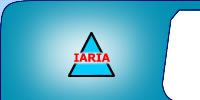

 |
The Fourth International Conference on Sensor Technologies and Applications SENSORCOMM 2010 July 18 - 25, 2010 - Venice/Mestre, Italy |
|
|||||||||||||||
| Details: |
Keynote Speaker: Jean-Phillippe Vasseur, Cisco Systems, Inc., USA |
All CPS Publications are included in the IEEE Xplore All CPS Publications are archived in IEEE Computer Society Digital Library (CSDL) Authors of selected papers will be invited to submit an extended version to the "Sensors and Transducers Journal" Authors of selected papers will be invited to submit extended versions to a IARIA Journal |
All tracks/topics are open to both research and industry contributions.
Tracks:
APASN: Architectures, protocols and algorithms of sensor networks
Network planning, provisioning and deployment; Network Architectures for Sensor Networks; Network Protocols for Sensor Networks; Structural design; Distributed Sensor Networks; Dynamic sensor networks; Scalable and heterogeneous architectures; Hierarchical clustering architectures; Group-based Architectures; Network topologies; Mesh networking; Device centric sensor networks; Distributed coordination algorithms; Topology construction; Routing protocols; Routing Metrics; Distributed Algorithms; Attribute-based named nets; Mobility and Scalability; Attribute-based named Sensor Networks; Query optimization; Self-organization and self-configuration algorithms; Reconfigurability; Time Synchronization; MAC protocols for sensor networks (801.11, 802.15.4, UWB, etc); Location and time service; Integration with other systems; Distributed inference and fusion; Cross-layer design and optimization; Complexity analysis of algorithms; Sensor networks and the Web; Integration with other systems (e.g., Web-based information systems, process control, enterprise software, etc.); Target tracking; RFID tags; Traffic scheduling
MECSN: Energy, management and control of sensor networks
Energy models; Energy optimization; Energy management; Power-aware and energy-efficient design; Power sources in sensor networks; Battery technology; Power management; Algorithms and theories for management; Communication strategies for topology control; Algorithms and theories for supervisory control; Sensor tasking and control; Distributed control and actuation; Location and mobility management; Bandwidth management; Distributed networked sensing; Resource provisioning; Resource management and dynamic resource management; Schemes to maximize accuracy and minimize false alarms; Online self-calibration and self-testing; Handoff and mobility management and seamless internetworking; Distributed actuation and control; Topology control
RASQOFT: Resource allocation, services, QoS and fault tolerance in sensor networks
Algorithms to support quality of service in sensor networks; Protocols to support quality of service in sensor networks; QoS/SLA in sensor networks; Provisioning of QoS in terms of bandwidth and delay assurance; System services and distributed services in sensor networks; Delay tolerant networks and opportunistic networking; Failure resilience and fault isolation; Information assurance in sensor networks; Fault tolerance and reliability; Admission control; Resource allocation and fairness; Real-time resource scheduling; Scheduling and optimisation; Capacity planning
PESMOSN: Performance, simulation and modelling of sensor networks
Performance measurement of sensor networks; Performance evaluation and analysis of sensor networks; Performance comparison on capacity, coverage and connectivity; Modelling techniques of sensor networks; Validation of sensor network architectures; Simulation and theoretical analysis; Simulation software tools and environments; Theoretical performance analysis: complexity, correctness and scalability; Design, simulation and optimization tools for deployment and operation; Platform modelling and analysis tools; Analytical, mobility and validation models; System debugging and testing
SEMOSN: Security and monitoring of sensor networks
Security and privacy in sensor networks; Reliability aspects in sensor networks; Monitoring distributed sensor networks; Mechanisms for authentication; Secure communication in sensor networks; Encryption algorithms for sensor networks; Sensor secure management; Data integrity; Trustworthiness issues in sensor networks; Trade-off analysis
SECSED: Sensor circuits and sensor devices
Methods for sensor deployment; Instrumentation and models for deployment of sensors networks; Sensor architecture; Abstractions for modular design; Design and deployment of embedded system platforms; Embedded architectures and tools; Embedded processors; Embedded chip design; Micro and Nano devices; Biosensors; Optical sensors; Smart sensors; Acoustic Sensors; Microwave sensors; Middleware design; Sensor Prototypes; Sensor node components; Sensor interfaces; Actuators; Independent Component Analysis; Design of cost effective and economical sensors; Smart Material Applications to design sensors; Microfabrication Technologies for Microsystem Integration; Integration of sensors into engineered systems; Hardware platforms; Test-beds incorporating multiple sensors; Operating system and middleware support
RIWISN: Radio issues in wireless sensor networks
Wireless Sensor Communications; Network connectivity & longevity; Tracking objects; Geo-location problems; Network coverage; Algorithms for sensor localization and tracking; Detection, classification and estimation; Physical layer impact on higher level protocols; Directional and smart antennas for sensor networks; Coverage maintenance; Transceiver and antenna design; Ubiquitous wireless connectivity
SAPSN: Software, applications and programming of sensor networks
Applications and demonstrations of sensor networks; Software platforms and development tools; Architectural design and optimization tools for sensor nodes; Computation and programming models of sensor networks; Languages and operating systems of Sensors; Programming and Interfacing; Programming abstraction; Programming models for sensors; Programming methodology for sensor environments; Intelligent sensor theory and applications; Machine learning applications to sensor networks; Wireless sensor applications; Applications for sensor network management; Software tools for chip programming; Application requirements; Application evaluation and comparison; Demos and prototype testing
DAIPSN: Data allocation and information in sensor networks
Techniques for the interpretation and use of sensor data in decision-making processes; Distributed data processing; Distributed signal processing; Array signal processing; Statistical signal processing; Distributed query processing; Distributed information processing; Distributed algorithms for collaborative information and signal processing; Task allocation, reprogramming and reconfiguration; Coding and information theory; In-network processing and aggregation; Data analysis and visualisation; Data storage in sensor networks; Data retrieval; Data dissemination; Data compression and aggregation; Data transport in wireless sensor networks; Data gathering and fusion in wireless sensor networks; Theories and models on fundamental information and communication aspects of sensor networks; Redundancy
DISN: Deployments and implementations of sensor networks
Methods for sensor networks deployment; Practical implementations and real-world experiences; Real-life deployments; System implementation; End-user aspects; Operational experience and test-beds; Industrial and commercial developments and applications; Measurements from experimental systems, test-beds and demonstrations; Intelligent sensors, body sensors and their utilisation; Analysis of real-world systems and fundamental limits; Smart Sensors for building surveillance; Sensing in health care; Games using sensor networks; Peer-to-peer, overlay, and content distribution wireless sensor networks; Use cases (e.g., Automotive, Battlefield, Defense, Construction, Disaster recovery, Environmental, Medical, Security, Biomedical, Unmanned Aerial Vehicles, etc.); Sensor networks for Rural and Agricultural environments; Sensors for railway systems; Pattern Recognition; Machine Intelligence; Sensor-equipped Smart Environment; Deployments in Harsh Environments; Potential application areas
UNWAT: Under water sensors and systems
Protocols for underwater sensor networks; Underwater hardware; Underwater wired systems; Underwater wireless sensor networks; Underwater sensors for neutrino telescopes; Acoustic and radio underwater communication; Aquatic environments and applications; Unmanned underwater exploration; Underwater localization and knowledge acquisition; Scalable underwater monitoring and measurement systems; Fixed and mobile underwater wireless sensors; Aquatic surveillance applications; QoS/Performance in underwater communication; Surface-floating and underwater sensor communication; Access control in underwater networks; Latency effects for critical applications and synchronization; Synchronization and delays in underwater sensor networks; Localization in underwater sensor networks; Advanced underwater sensor-based applications
ENOPT: Energy optimization in wireless sensor networks
Energy supply, lifetime and transmission power; Energy efficiency; State-driven energy optimization; Power consumption models; Energy-aware adaptive low power; Optimal energy-aware clustering; Lifetime-oriented energy provisioning; Sensor placement and accessibility; Random sensor deployment and density function; Fixed and adjustable transmission power; Traffic and energy consumption rate; Energy-efficient topology control; Energy optimization in multi-hop communications; Energy harvesting for autonomous sensors






